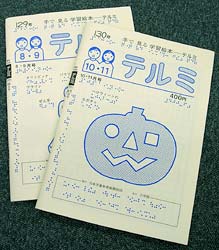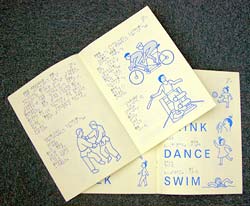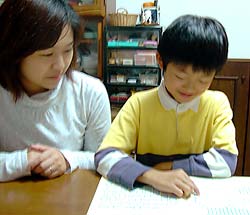|
MONTHLY NEWS Braille Magazine Enables Children to "See" Pictures by Touch | ||||||||||||
Terumi, an illustrated magazine that can be enjoyed by touching the raised shapes, recently celebrated its twenty-first anniversary. Published every two months by the Foundation for the Advancement of Juvenile Education in Japan, it has been cherished by generations of visually impaired children as a rare source of knowledge about the shapes of things. The pictures and Braille writing are raised from the surface of the paper by printing them with a special kind of ink that puffs up when heated. Blue is the easiest color for people with weak eyesight to see, so that's the color that is used for this ink. But as the text is also printed with regular black ink, teachers and families can enjoy the magazine together with the children. Terumi has more than 500 regular readers.
Braille is a code consisting of raised dots that can be read by touching them with your fingers; the arrangement of the dots communicates what each symbol stands for. Japanese Braille symbols represent individual sounds, just like the hiragana and katakana alphabets. Each English Braille symbol represents a letter of the alphabet. (In English Braille, symbols representing words or abbreviations of words are also used in longer text.) Terumi has a section on learning English that gives the spellings of words like dance, along with pictures describing the words. A special English-only edition that was printed in 1992 included maps of the world and of Japan and introductions to Japanese festivals. The book is sure to have helped visually impaired children from other countries learn about Japan. Commemorating the Athens Olympic and Paralympic Games, a recent issue of Terumi featured different kinds of sports events. Meanwhile, games are always popular, especially mazes. Many children say they feel very happy when they finally reach the goal of the maze after making many mistakes along the way.
Postcards are included in every issue of Terumi for readers to write in with their views, and each month the editorial staff receives many comments written on these cards by teachers and families on behalf of the children. They all say how much the children look forward to getting the magazine. An 11-year-old girl living in Okinawa Prefecture commented, "I want the magazine to become monthly." An 8-year-old boy in Yamagata Prefecture wrote, "Please put mazes on every page." "It costs five times the price of the magazine to make each copy, so it's hard," explains Hatta Hisaya, the executive editor of Terumi. "But when we meet the children who read the magazine and see how excited they are, we can't stop publishing Terumi." The tactile magazine will continue to be published with donations and cooperation from a publisher of children's books. |
 |


